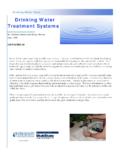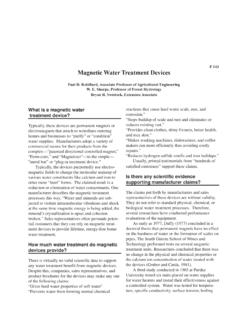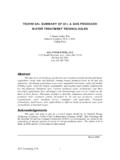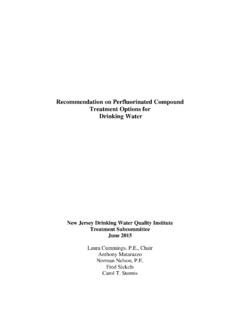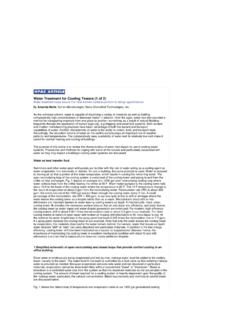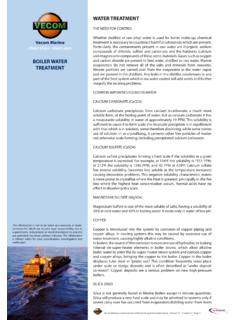Transcription of 6. Water treatment - WHO | World Health …
1 Treatment6. Water can be contaminated by the following agents: Pathogens disease-causing organisms that include bacteria, amoebas and viruses,as well as the eggs and larvae of parasitic worms. Harmful chemicals from human activities (industrial wastes, pesticides, fertilizers). Chemicals and minerals from the natural environment, such as arsenic, common saltand fluorides. Some non-harmful contaminants may influence the taste, smell,colour or temperature of Water , and make it unacceptable to the from surface sources is often contaminated by microbes, whereas groundwater isnormally safer, but even groundwater can be contaminated by harmful chemicals fromhuman activities or from the natural environment.
2 Rainwater captured by a rooftop har-vesting system or with small catchment dams is relatively safe, provided that the firstwater is allowed to flow to waste when the rainy season starts. The amount of Water to betreated should also be assessed. This can be estimated by assuming that each person willneed a minimum of 20 50 litres of Water a day for drinking, cooking, laundry and per-sonal community should be consulted when choosing a Water - treatment system and shouldbe made aware of the costs associated with the technology. In particular, communitymembers should be made aware of the behavioural and/or cultural changes needed tomake the system effective over the long-term and thus be acceptable to them.
3 Communi-ties may also need to be educated about protecting Water sources from animal or humancontamination, and mobilized. It should be emphasized that all the positive effects of awater- treatment system could be jeopardized if the Water is not drawn, stored and trans-ported carefully and Fact Sheets in this section deal with both community and household methods fortreating Water . Some household treatment methods and their effectiveness are summa-rized in Table , whereas the following household and community Water -treatmenttechnologies are described in greater detail:Household Water - treatment systems boiling; household slow sand filter; domestic Water - treatment systems storage and sedimentation; up-flow roughing filter; slow sand filtration.
4 Chlorination in piped Water -supply TECHNOLOGY CHOICE WITH OPERATION AND MAINTENANCE72 TABLE Water - treatment SYSTEMS AND THEIR EFFECTIVENESSaEffectiveness over factors that affect Water qualityBacteria,Guinea-Odour,OrganicTrea tment systemamoebaswormCercariaFe, MnFluorideArsenicSaltstastematterTurbidi tyStraining through fine clothConsists in pouring raw Water b through a piece of fine, clean,cotton cloth to remove someof the suspended iron (Fe) and mang- anese (Mn). Good aeration ofthe Water is also important forslow, sand filtration to beeffective, especially if there isnot enough oxygen in thesurface Water . Water can easilybe aerated by shaking it in avessel, or by allowing it totrickle through perforated trayscontaining small Water for only one day can eliminate some bacteria,but it should be stored for 48hours to eliminate cercaria (snaillarvae).
5 The longer the Water isstored, the more the suspendedsolids and pathogens will settleto the bottom of the top Water can then be usedafter , flocculationand settlementIn coagulation, a liquid coagu- lant, such as aluminium sulfate,is added to the Water to attractsuspended particles. The wateris then gently stirred to allow theparticles to come together andform larger particles (floccula-tion), which can then beremoved by sedimentation,settlement or filtration. Theamount of coagulant neededwill depend on the nature of thecontaminating chemicalcompounds and sand filtrationWater passes slowly downwards through a bed of fine sand at asteady rate.
6 The Water shouldnot be too turbid, otherwise thefilter will get clogged. Patho-gens are naturally removed inthe top layer where a biologicalfilm builds up. A potentialproblem is that some house-holds do not use this technologyeffectively and the Water canremain from: Skinner & Shaw (1998).bThe treatments were categorized as being: of no effect, or of unknown effectiveness ( ); of little effect ( ); moderately effective( ); highly effective ( ).73 TABLE over factors that affect Water qualityBacteria,Guinea-Odour,OrganicTrea tment systemamoebaswormCercariaFe, MnFluorideArsenicSaltstastematterTurbidi tyRapid sand filtrationThe sand used is coarser than in slow sand filtration and theflow rate is higher.
7 The methodis used to remove suspendedsolids and is effective after thewater has been cleared withcoagulation/flocculation. Thereis no build-up of biological film,hence the Water will still needto be disinfected. It is easier toremove trapped debris fromupflow sand filters, comparedto filters in which the waterflows filterGranular charcoal (or granu- lated activated carbon) can beused in filtration and is effectivein improving the taste, odourand colour of the Water . How-ever, it should be replacedregularly, because bacteriacan breed in filterThe filter is a porous, unglazed ceramic cylinder and impuritiesare deposited on its with very small porescan remove most , porous ceramic jars canalso be used.
8 The ceramic filtermethod can only be used withfairly clear disinfectionUltraviolet radiation from the sun will destroy most patho-gens, and increasing thetemperature of the waterenhances the effectiveness ofthe radiation. In tropical areas,most pathogens can be killedby exposing the contaminatedwater to sun for five hours,centred around midday. An easyway to do this, is to expose(half-blackened) clear glass/plastic bottles of Water to thesun. Shaking the bottle beforeirradiation increases theeffectiveness of the Water must be clear forthis treatment to be Water TREATMENTLINKING TECHNOLOGY CHOICE WITH OPERATION AND MAINTENANCE74 TABLE over factors that affect Water qualityBacteria,Guinea-Odour,OrganicTrea tment systemamoebaswormCercariaFe, MnFluorideArsenicSaltstastematterTurbidi tyChemical disinfectionChlorination is the most widely used method of disinfectingdrinking- Water .
9 Liquids (suchas bleach), powders (such asbleaching powder), andpurpose-made tablets can beused. Iodine can also be usedas a chemical on the right amount ofchlorine to use can be difficult,because the effectiveness ofchlorination depends on thequality of the untreated Water ,which may vary according tothe the Water to a rolling boil will kill most pathogens,and many are killed at lowertemperatures ( 70 C). Thisapproach can be expensive,however, because fuel/charcoalis needed to boil the by distillation produces Water withoutchemical salts and the methodcan be used at household method can be expensivebecause of the capital invest-ment needed and becausefuel/charcoal is used to heatthe Water .
10 The volume of waterproduced is also Water be chlorinated?1 The Water - treatment methods described above can reduce the number of pathogens inwater, but do not always eliminate them completely. And although boiling and solar dis-infection are effective, the methods are impractical with large volumes of Water . In con-trast, chemical disinfection inactivates pathogenic organisms and the method can beused with large volumes of Water . Chlorine compounds usually destroy pathogens after30 minutes of contact time, and free residual chlorine ( mg per litre of treatedwater) can be maintained in the Water supply to provide ongoing disinfection.










